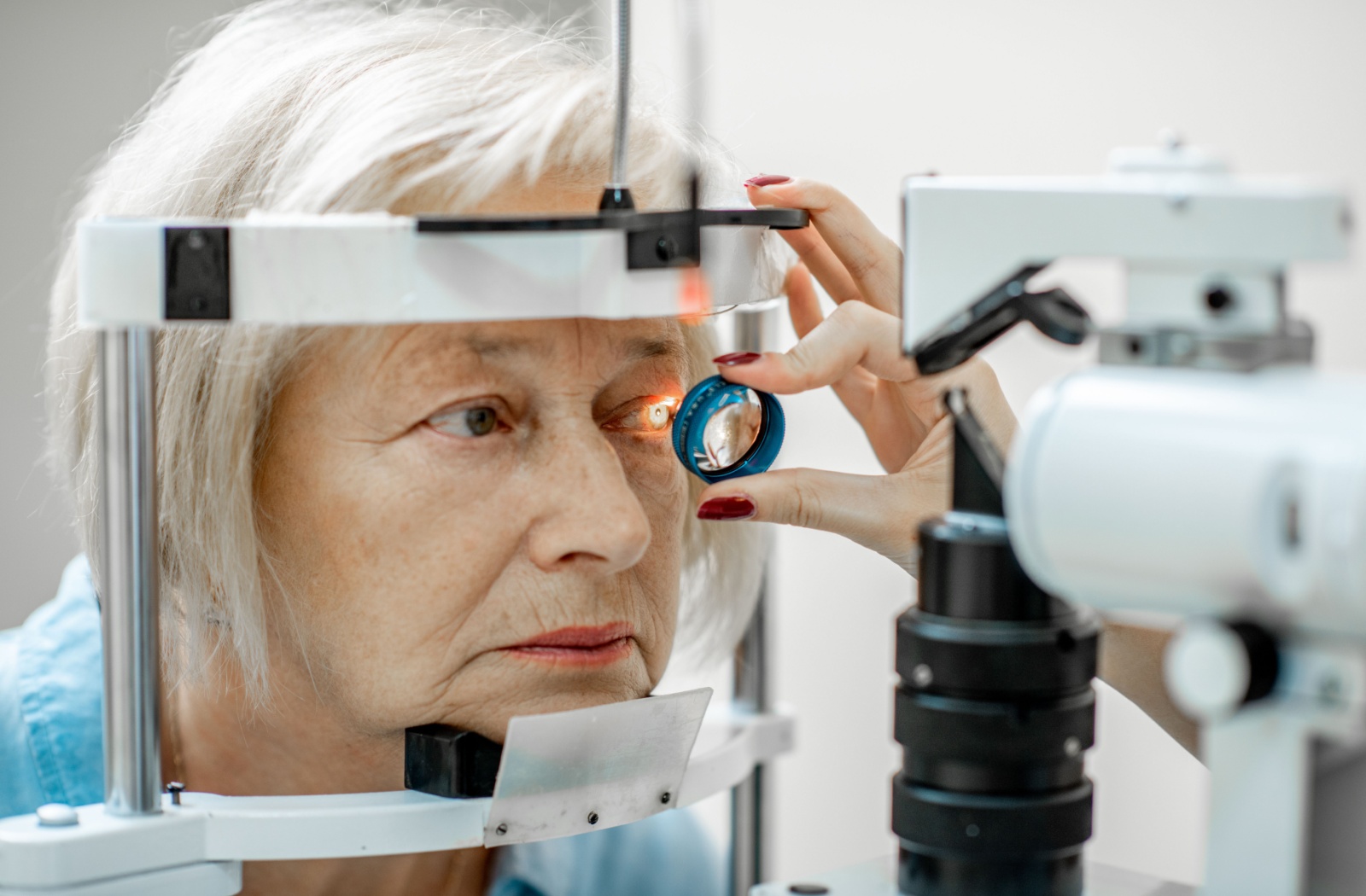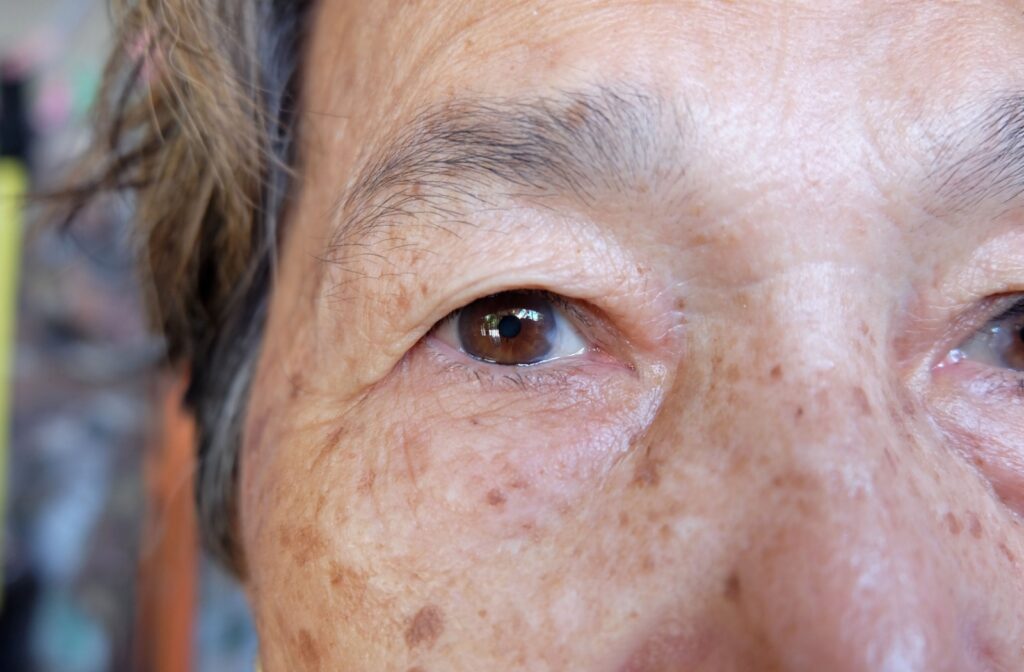If you’ve noticed that your vision has become blurry, hazy, or dim, the problem might not be your glasses. These changes could point to cataracts—a common condition that affects many people as they age.
Cataracts often develop slowly, making early symptoms like blurry vision, sensitivity to light, faded colours, and poor night vision easy to overlook. But recognizing these changes early is key to maintaining good eyesight.
While a formal diagnosis will come from your optometrist, knowing what to watch for can help you decide when it’s time to book an eye exam.
What Are Cataracts?
Cataracts form when the natural lens inside your eye develops cloudiness that restricts flexibility. The lens, located just behind the coloured part of your eye (the iris), normally focuses light onto your retina, allowing you to see clearly.
As cataracts progress, the lens becomes increasingly opaque, leading to a gradual decline in vision quality.
Cataracts are usually a result of aging, but they can also be caused by:
- Diabetes
- Eye injuries
- Long-term UV exposure
- Use of certain medications (like corticosteroids)
- Genetic factors
Most people over 70 will develop some level of cataract formation, even if it’s not yet affecting their vision.
Common Signs & Symptoms of Cataracts
Cataracts often develop slowly without discomfort, so it’s easy to overlook the signs. If you’re wondering whether changes in your vision might be related to cataracts, consider these common symptoms.
Blurry or Cloudy Vision
One of the earliest and most noticeable symptoms is blurry, hazy, or foggy vision. It can seem like looking through a frosted window or smeared glasses.
Increased Sensitivity to Light
Light sensitivity, glare and halos around lights can make both daylight and nighttime light sources uncomfortable. You might squint more often in bright sunlight or while driving at night. Oncoming headlights may appear uncomfortably intense, and glare can become a significant nuisance.
Poor Night Vision
Cataracts can reduce your ability to see in low-light conditions. You might struggle with night driving or reading in dim light. Driving after dark can feel increasingly more stressful or unsafe.
Faded or Yellowed Colours
Colours may lose their vibrancy or begin to appear duller. You may also notice a yellow or brownish tint to everything you see.
Doubling Vision/Ghosting in One Eye
Double vision (or seeing ghosting around images) can be a frustrating symptom, making simple tasks, such as reading or driving, challenging.
Frequent Prescription Changes
When you frequently need to update your glasses or contact lens prescription to restore clear vision, it can be a sign that cataracts are progressing.

Self-Test for Cataracts: Questions to Ask Yourself
While a self-test can’t replace a professional eye exam, if you are over 65, asking yourself the following questions may help you determine whether it’s time to book an appointment with your optometrist:
- Has your vision become blurry or cloudy, even with your current glasses?
- Are you more sensitive to bright light or glare than you used to be?
- Do you see halos around lights at night?
- Have colours begun to appear faded or yellowed?
- Is your night vision noticeably worse than before?
- Are you struggling with depth perception or contrast in low light?
- Have you needed frequent changes to your glasses or contacts?
- Do you experience ghosted images in one eye?
Visit your eye doctor if you answered “yes” to 2 or more of these questions. Cataracts are treatable—but only if they’re diagnosed.
At-Home Vision Checks You Can Try
Here are a few simple checks you can do at home that may reveal signs of cataracts.
Compare Vision Between Eyes
Cover one eye at a time and compare what you see. Is one eye noticeably blurrier than the other? Do lights appear different? It’s a simple exercise that can help isolate cataract development in one eye.
Assess Colour Perception
Look at a brightly coloured object (like a red or green item of clothing) in natural daylight. Does it appear less vivid than it used to? Try comparing your view through each eye.
Night Vision Test
Take note of how comfortable you feel walking around your home at night with low lighting. It could be a sign of cataract-related light sensitivity if you’re struggling more than usual, especially when moving between lit and unlit areas.
These home checks are not a substitute for medical advice. Still, spotting signs can alert you to potential changes worth discussing with your optometrist.
Why Early Detection Matters
Your eye doctor can help you monitor cataracts effectively, especially when detected early. In the early stages, changes of prescriptions or anti-reflective lenses may be sufficient to improve your vision. Blue light filter coatings can help reduce glare, especially at night.
However, your eye doctor may recommend cataract surgery once cataracts begin to interfere with daily activities, such as reading, driving.
Cataract surgery is one of the most common and safest procedures performed in Canada. It involves replacing the cloudy lens with a clear artificial one. Most people experience a dramatic improvement in vision and quality of life following the surgery.
When to See an Eye Doctor
Many cataract symptoms overlap with other eye conditions, including age-related macular degeneration, glaucoma, and diabetic retinopathy. Self-tests can help you monitor your vision so you can notice early signs, especially if you are over 50 or have other risk factors.
- You’ve noticed any of the signs or symptoms mentioned above
- You haven’t had a comprehensive eye exam in the past year
- You have diabetes, a history of eye disease, or a family history of cataracts
- You’ve had recent changes in vision or visual comfort
Professional Support Close to Home
Early detection of cataracts starts with a thorough eye health assessment. Your optometrist can examine your visual acuity, evaluate your eye’s lens, and determine whether cataracts are present and how advanced they may be.
When treatment is the right step for you, your eye doctor can thoroughly explain your options and refer you for a surgical consultation if needed. The goal is always the same: helping you see clearly, comfortably, and confidently.
At Discover Eyecare, with convenient locations in Abbotsford and Chilliwack, BC, we’re committed to supporting your lifelong vision. Our team offers compassionate, comprehensive care, including cataract evaluations, referrals, and surgical support.
If you’ve noticed changes in your vision, book your eye exam today.



